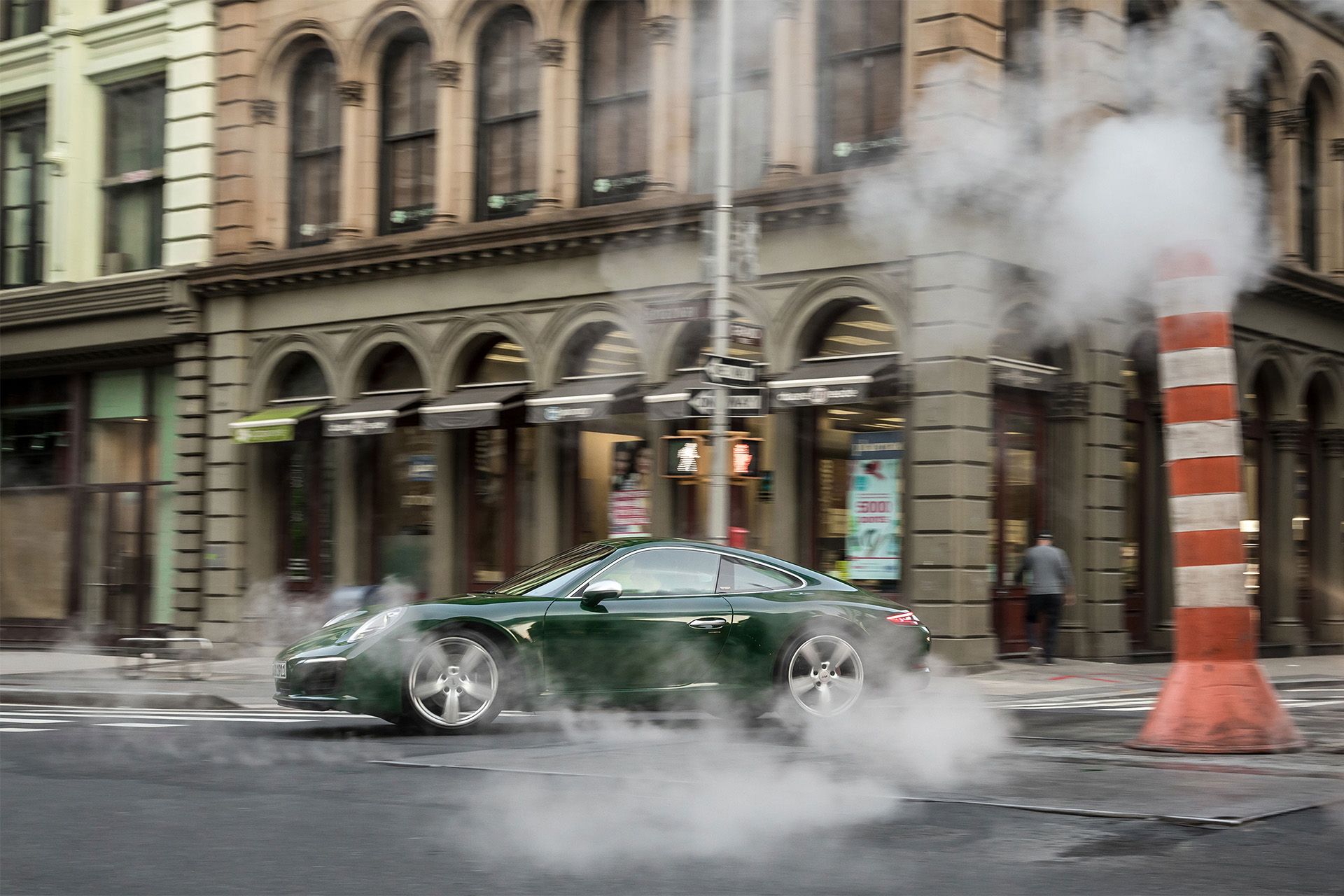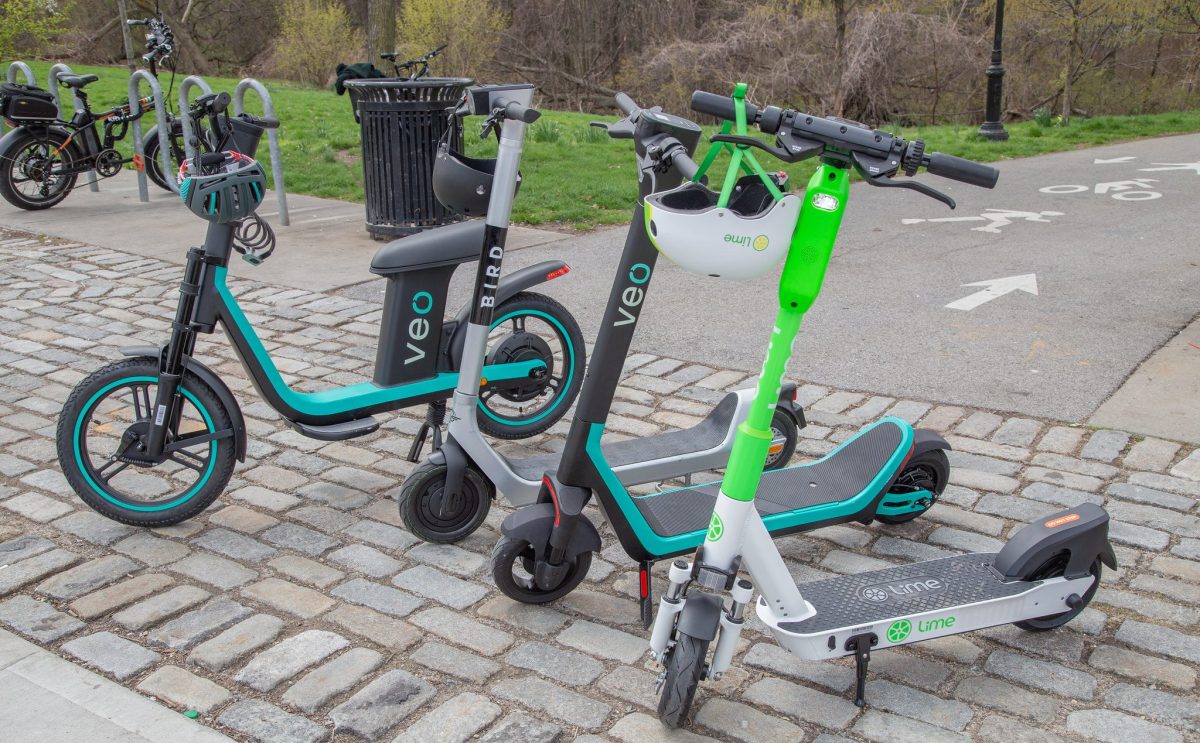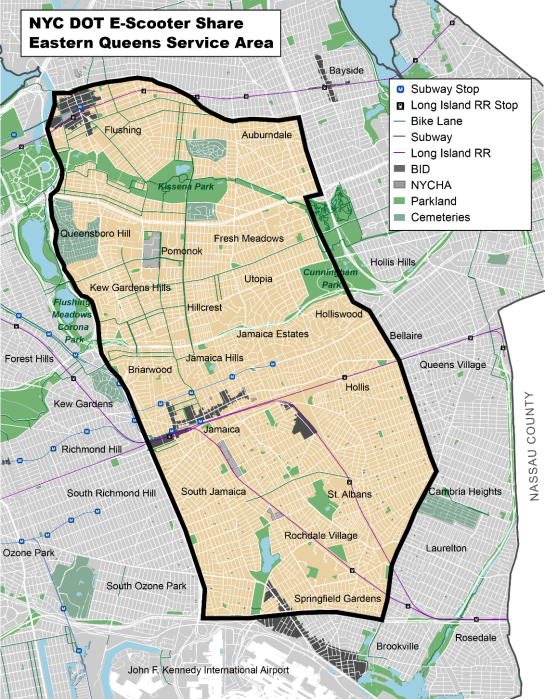ABOUT DOT
May 9, 2024
Contact: (212) 839-4850, press@dot.nyc.gov
NEW YORK — New York City Department of Transportation (NYC DOT) Commissioner Ydanis Rodriguez today announced a major step to launch a network of 500 secure bike parking locations beginning next year. Publicly accessible secure bike parking will support New York City’s record bike ridership and continued growth. The first step in this initiative was taken today with an open call to identify a company to operate this groundbreaking bike storage network. With more than 600,000 bicycling trips taken in the city each day and a record high number of protected bike lanes across the five boroughs, secure bike parking access will continue to fuel New Yorkers’ embrace of cycling, a safe and environmentally friendly transportation option. This secure bike storage network is critical because many New Yorkers lack in-home bike storage space or cannot carry heavier e-bikes or cargo bikes up stairs in apartment buildings, significant barriers to bike ownership.
“As more people ride bikes to get around, including heavier and pricier e-bikes, we must create infrastructure for safe, convenient storage, as one of the many highest and best uses for our roadways,” said Deputy Mayor for Operations Meera Joshi. “New York must be built for people, at the density our growing city requires. These storage lockers will create many more spaces for New Yorkers commuting needs on our limited roadway.”
“With record bike ridership and an all-time high number of protected bike lanes, New York City is experiencing a booming cycling renaissance,” said NYC DOT Commissioner Ydanis Rodriguez. “This initiative will support continued growth in cycling by addressing a key barrier to bike ownership: the lack of access to secure bike storage.”
"Providing residents with secure bike parking is instrumental in ensuring more New Yorkers are walking, biking and using mass transit, which helps to cut our greenhouse gas emissions,” said Mayor’s Office of Climate & Environmental Justice Executive Director Elijah Hutchinson. “New Yorkers require a mixture of travel options to meet their daily needs and this RFP presents more green alternatives while also helping us meet our PlaNYC commitments of creating thousands of secure public bike parking spots and achieving a sustainable mode share of 80% by 2050.”
Once an operator is selected, NYC DOT expects to have the first storage locations available next year and for all 500 locations to be in place within five years. NYC DOT will prioritize locations and storage designs to:
The agency will install storage locations equitably across the five boroughs to help ensure all New Yorkers can experience the benefits of cycling. The open call for operators was launched via a Request for Proposal (RFP) issued this morning. This secure bike storage network will support the Adams Administration’s PlaNYC 2.0 targets, NYC DOT’s Curb Management Action Plan, and the New New York Panel’s Making New York Work for Everyone Action Plan.
Enclosed small-capacity units
On-street bike parking is a far more efficient way to serve commuters, with the size of one vehicle parking space accommodating 10 to 12 standard bicycles. NYC DOT plans for enclosed, small-capacity units placed at the curb in residential areas to accommodate either standard-sized bikes or cargo and adaptive bicycles. The agency expects these units to represent the majority of the facilities installed under the program.
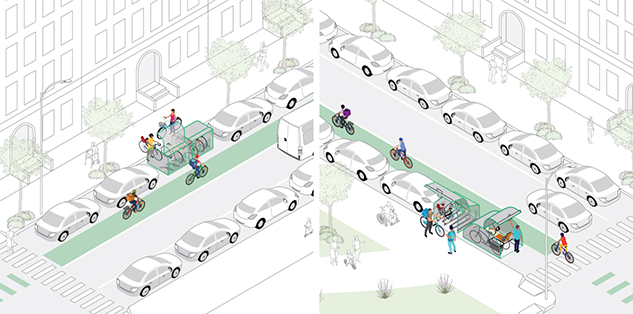
Two example designs for small capacity bike parking facilities. Credit: NYC DOT
Enclosed high-capacity units
NYC DOT is planning to place high-capacity parking units near transit hubs and other major destinations, with the aim to accommodate dozens of bikes at a time. These facilities would be off-street with flexible designs and parking capacities based on available space. They will accommodate cargo bikes, adaptive bikes, and have the potential to provide charging for e-bikes.
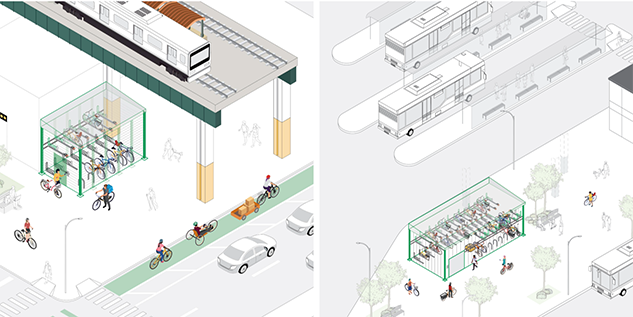
Two example designs for high-capacity bike parking facilities. Credit: NYC DOT
Self-locking racks
NYC DOT will also install open-air self-locking racks, which provide flexibility regarding placement possibilities and the types of bikes that can be accommodated. These racks can be placed on the sidewalk or at the curb. They can accommodate all bike sizes and configurations and have the potential to provide charging options for e-bikes.
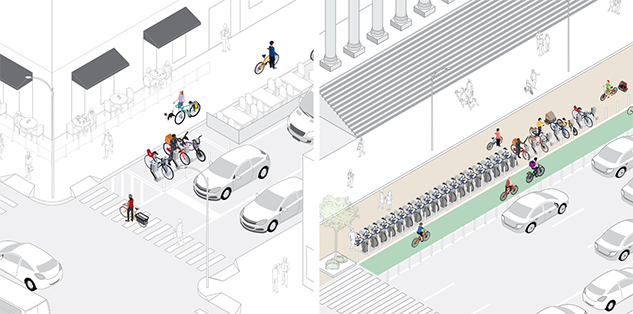
Two potential designs for self-locking racks, with one rack set nearby the intersection to improve visibility (left) and another adjacent to a bikeshare station (right). Credit: NYC DOT
“Biking is an integral part of a more sustainable New York, so I’m thrilled that the City is taking steps to make cycling more accessible to thousands of riders,” said Manhattan Borough President Mark Levine. “By reducing barriers to bike ownership, these secure parking locations will mean a greener New York.”
“We can encourage people to make better, greener transit decisions by making alternatives like biking safer, easier, and more accessible. It’s infrastructure like bike storage and protected bike lanes that are necessary to get more New Yorkers onto bikes,” said Brooklyn Borough President Antonio Reynoso. “Thank you, DOT, for this work to begin to advance a bike storage network so more New Yorkers can get out of their cars and enjoy the open air on two wheels.”
“The creation of this network of secure bike parking locations will go a long way toward making bike ownership more feasible for people in Queens and throughout our city,” said Queens Borough President Donovan Richards Jr. “These locations will give bicyclists the peace of mind in knowing they can safely secure their bikes once they reach their destinations. I fully support the DOT’s ongoing efforts to encourage bicycling, as it is a great way to help unclog our roads and reduce pollution.”
“As New Yorkers embrace more sustainable modes of travel, investments in bicycle parking will support continued growth in bicycling trips. Using a bike to get around is good for health and the environment, and I commend DOT for their continued commitment to expanding cycling-related infrastructure,” said Councilmember Carlina Rivera.
“We’re thrilled by the news that NYC DOT is issuing an RFP for the creation of a robust secure bike parking system across New York City,” said Eric McClure, executive director of StreetsPAC. “Fear of theft and the absence of safe parking options is a major barrier to wider adoption of cycling, and the creation of a widespread network of secure facilities will undoubtedly help the city take another substantial step toward becoming one of the world’s great places for biking.”
“Ensuring that New Yorkers have secure bike parking is a critical component to the continuing growth of bicycling across the city,” said Ken Podziba, CEO of Bike New York. “This major increase in bike storage will make bicycling significantly easier and more accessible and a broad bike parking network can be as transformative to cyclists as protective bike lanes and Citi Bikes.”
“When New Yorkers can rely on secure, convenient bike storage — at home and at their destination — they’re much more likely to ride,” said Jackson Chabot, director of advocacy and organizing at Open Plans. “We’re glad to see DOT committing to providing this at 500 new locations throughout the city. Biking is booming, but logistical and physical factors still keep many New Yorkers from doing it. This storage will get us a little closer to breaking down those barriers and inspiring more adoption of this fun and climate-friendly way to get around.”
"With congestion pricing on the horizon and the bike boom showing no signs of slowing down, making it easier and more convenient for New Yorkers to bike is key to growing ridership and reducing car usage,” said Elizabeth Adams, deputy executive director for public affairs at Transportation Alternatives. “In a city with more bikes than cars, the launch of a secure bike parking program in New York City is great news for riders, especially for those without in-home room or who cannot lift bikes up stairs. We look forward to cutting the ribbon on secure locations in the months to come.”
Press Releases
IMMEDIATE RELEASEMay 9, 2024
Contact: (212) 839-4850, press@dot.nyc.gov
NYC DOT Takes Major Step to Launch Network of 500 Secure Bike Parking Locations Next Year
Publicly accessible secure bike parking will support New York City’s record bike ridership by providing new options for residents without in-home bike storage space
Today begins an open call to identify a company to operate the bike storage network
Today begins an open call to identify a company to operate the bike storage network
NEW YORK — New York City Department of Transportation (NYC DOT) Commissioner Ydanis Rodriguez today announced a major step to launch a network of 500 secure bike parking locations beginning next year. Publicly accessible secure bike parking will support New York City’s record bike ridership and continued growth. The first step in this initiative was taken today with an open call to identify a company to operate this groundbreaking bike storage network. With more than 600,000 bicycling trips taken in the city each day and a record high number of protected bike lanes across the five boroughs, secure bike parking access will continue to fuel New Yorkers’ embrace of cycling, a safe and environmentally friendly transportation option. This secure bike storage network is critical because many New Yorkers lack in-home bike storage space or cannot carry heavier e-bikes or cargo bikes up stairs in apartment buildings, significant barriers to bike ownership.
“As more people ride bikes to get around, including heavier and pricier e-bikes, we must create infrastructure for safe, convenient storage, as one of the many highest and best uses for our roadways,” said Deputy Mayor for Operations Meera Joshi. “New York must be built for people, at the density our growing city requires. These storage lockers will create many more spaces for New Yorkers commuting needs on our limited roadway.”
“With record bike ridership and an all-time high number of protected bike lanes, New York City is experiencing a booming cycling renaissance,” said NYC DOT Commissioner Ydanis Rodriguez. “This initiative will support continued growth in cycling by addressing a key barrier to bike ownership: the lack of access to secure bike storage.”
"Providing residents with secure bike parking is instrumental in ensuring more New Yorkers are walking, biking and using mass transit, which helps to cut our greenhouse gas emissions,” said Mayor’s Office of Climate & Environmental Justice Executive Director Elijah Hutchinson. “New Yorkers require a mixture of travel options to meet their daily needs and this RFP presents more green alternatives while also helping us meet our PlaNYC commitments of creating thousands of secure public bike parking spots and achieving a sustainable mode share of 80% by 2050.”
Once an operator is selected, NYC DOT expects to have the first storage locations available next year and for all 500 locations to be in place within five years. NYC DOT will prioritize locations and storage designs to:
- Improve bike parking near major transit hubs
- Provide options to accommodate e-bikes and cargo bikes
- Offer long-term storage in residential areas for New Yorkers without space for in-home storage.
- Potentially incorporate e-bike charging in storage facilities.
The agency will install storage locations equitably across the five boroughs to help ensure all New Yorkers can experience the benefits of cycling. The open call for operators was launched via a Request for Proposal (RFP) issued this morning. This secure bike storage network will support the Adams Administration’s PlaNYC 2.0 targets, NYC DOT’s Curb Management Action Plan, and the New New York Panel’s Making New York Work for Everyone Action Plan.
SECURE BIKE PARKING MODELS
NYC DOT envisions a variety of small and high-capacity secure parking facility designs, including enclosed and open-air units both at the curbside and off-street.Enclosed small-capacity units
On-street bike parking is a far more efficient way to serve commuters, with the size of one vehicle parking space accommodating 10 to 12 standard bicycles. NYC DOT plans for enclosed, small-capacity units placed at the curb in residential areas to accommodate either standard-sized bikes or cargo and adaptive bicycles. The agency expects these units to represent the majority of the facilities installed under the program.

Two example designs for small capacity bike parking facilities. Credit: NYC DOT
Enclosed high-capacity units
NYC DOT is planning to place high-capacity parking units near transit hubs and other major destinations, with the aim to accommodate dozens of bikes at a time. These facilities would be off-street with flexible designs and parking capacities based on available space. They will accommodate cargo bikes, adaptive bikes, and have the potential to provide charging for e-bikes.

Two example designs for high-capacity bike parking facilities. Credit: NYC DOT
Self-locking racks
NYC DOT will also install open-air self-locking racks, which provide flexibility regarding placement possibilities and the types of bikes that can be accommodated. These racks can be placed on the sidewalk or at the curb. They can accommodate all bike sizes and configurations and have the potential to provide charging options for e-bikes.

Two potential designs for self-locking racks, with one rack set nearby the intersection to improve visibility (left) and another adjacent to a bikeshare station (right). Credit: NYC DOT
“Biking is an integral part of a more sustainable New York, so I’m thrilled that the City is taking steps to make cycling more accessible to thousands of riders,” said Manhattan Borough President Mark Levine. “By reducing barriers to bike ownership, these secure parking locations will mean a greener New York.”
“We can encourage people to make better, greener transit decisions by making alternatives like biking safer, easier, and more accessible. It’s infrastructure like bike storage and protected bike lanes that are necessary to get more New Yorkers onto bikes,” said Brooklyn Borough President Antonio Reynoso. “Thank you, DOT, for this work to begin to advance a bike storage network so more New Yorkers can get out of their cars and enjoy the open air on two wheels.”
“The creation of this network of secure bike parking locations will go a long way toward making bike ownership more feasible for people in Queens and throughout our city,” said Queens Borough President Donovan Richards Jr. “These locations will give bicyclists the peace of mind in knowing they can safely secure their bikes once they reach their destinations. I fully support the DOT’s ongoing efforts to encourage bicycling, as it is a great way to help unclog our roads and reduce pollution.”
“As New Yorkers embrace more sustainable modes of travel, investments in bicycle parking will support continued growth in bicycling trips. Using a bike to get around is good for health and the environment, and I commend DOT for their continued commitment to expanding cycling-related infrastructure,” said Councilmember Carlina Rivera.
“We’re thrilled by the news that NYC DOT is issuing an RFP for the creation of a robust secure bike parking system across New York City,” said Eric McClure, executive director of StreetsPAC. “Fear of theft and the absence of safe parking options is a major barrier to wider adoption of cycling, and the creation of a widespread network of secure facilities will undoubtedly help the city take another substantial step toward becoming one of the world’s great places for biking.”
“Ensuring that New Yorkers have secure bike parking is a critical component to the continuing growth of bicycling across the city,” said Ken Podziba, CEO of Bike New York. “This major increase in bike storage will make bicycling significantly easier and more accessible and a broad bike parking network can be as transformative to cyclists as protective bike lanes and Citi Bikes.”
“When New Yorkers can rely on secure, convenient bike storage — at home and at their destination — they’re much more likely to ride,” said Jackson Chabot, director of advocacy and organizing at Open Plans. “We’re glad to see DOT committing to providing this at 500 new locations throughout the city. Biking is booming, but logistical and physical factors still keep many New Yorkers from doing it. This storage will get us a little closer to breaking down those barriers and inspiring more adoption of this fun and climate-friendly way to get around.”
"With congestion pricing on the horizon and the bike boom showing no signs of slowing down, making it easier and more convenient for New Yorkers to bike is key to growing ridership and reducing car usage,” said Elizabeth Adams, deputy executive director for public affairs at Transportation Alternatives. “In a city with more bikes than cars, the launch of a secure bike parking program in New York City is great news for riders, especially for those without in-home room or who cannot lift bikes up stairs. We look forward to cutting the ribbon on secure locations in the months to come.”
